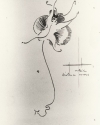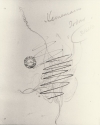The Paintings of James McNeill Whistler
M.1579
r.: Butterfly; v.: Butterfly with chequered wings

Date
r.: Butterfly; v.: Butterfly with chequered wings were intended for publication in Whistler 1899 (US)[more].

Butterfly, Pennell Collection, Library of Congress, Washington, DC

Butterfly with chequered wings, Pennell Collection, Library of Congress, Washington, DC
The sheet is catalogued in MacDonald 1995 (cat. rais.) [more] (cat. no. 1579).
Images

Butterfly, Pennell Collection, Library of Congress, Washington, DC

Butterfly with chequered wings, Pennell Collection, Library of Congress, Washington, DC
Subject
Description

Butterfly, Pennell Collection, Library of Congress, Washington, DC

Butterfly with chequered wings, Pennell Collection, Library of Congress, Washington, DC
The butterflies are derived, remotely, from Whistler's monogram 'JW', with the addition of long curvied barbed tails.
Comments
In 1894 William Eden (1849-1915) commissioned a portrait of his wife Sybil Frances Grey, Lady Eden (1867-1945). Whistler, dissatisfied with the amount (100gns) and manner of payment, retained and altered the portrait (Brown and Gold: Portrait of Lady Eden y408). After an appeal, in December 1897, the Court de Cassation let him retain the portrait but return the money. Whistler was well satisfied to see the Code Napoléon altered, to specify an artist's right to decide the fate of his works.
Whistler planned to publish an account of the affair, a compilation of letters, newspaper reports and legal documents, with William Heinemann (1863-1920), who had published the Gentle Art of Making Enemies in 1890. There was some problem with publishing in London, and, with Heinemann’s tacit agreement, Louis-Henry May in Paris took over the publication. A first proof was run off, using mainly butterflies originally drawn for the Gentle Art of Making Enemies. These butterflies were mostly replaced by new ones, in a second proof. There are at least two versions of some of the designs. They were slightly reduced in size in the final publication.
For the book, Whistler designed 15 butterflies, a club (A club on a cushion m1564), and a frog (Frog m1553). He also drew some butterflies which were not used (v.: Butterfly; r.: see No. 1268 m1572, Butterfly with chequered wings m1578, r.: Butterfly; v.: Butterfly with chequered wings m1579). The Baronet and the Butterfly was comparatively sparing of butterflies. Many marginal annotations, which in the Gentle Art of Making Enemies would have warranted a butterfly, did not get one. Some of the butterflies were very badly reproduced (r. and v.: Butterfly m1561, r.: Butterfly 'Encountered'; v.: Butterfly m1562). There were obviously publication problems, and it was not an entirely satisfactory venture. However, Whistler did not admit of criticism and seems, publicly, to have been entirely satisfied with the outcome.
Technique
Composition
r.: Butterfly; v.: Butterfly with chequered wings were intended for publication in Whistler 1899 (US)[more]. Neither drawing was used.
Technique

Butterfly, Pennell Collection, Library of Congress, Washington, DC

Butterfly with chequered wings, Pennell Collection, Library of Congress, Washington, DC
There is a guiding vertical pencil line. Whistler made white paint corrections on the antennae. A pencil outline to the wing, on the right, was printed as a black line in the proof.
Conservation History
There are two pinholes on the right side. It is on similar paper to v.: Butterfly; r.: see No. 1268 m1572.
A printed butterfly on a small rectangle of paper cut from Whistler 1890 [more] is stuck on the card, to indicate scale.
The butterfly on the verso was crossed out in ink.
History
Provenance
- 1917: possibly among four butterflies given by Elizabeth Robins Pennell (1855-1936) to the Library of Congress, Washington, DC.
Exhibitions
It was not exhibited in Whistler's lifetime.
Bibliography
Catalogues Raisonnés
- MacDonald, Margaret F., James McNeill Whistler. Drawings, Pastels and Watercolours. A Catalogue Raisonné, New Haven and London, 1995 (cat. no. 1579) as 'r.: Butterfly; v.: Butterfly with chequered wings'.
Authored by Whistler
- Whistler, James McNeill, Eden versus Whistler: The Baronet and the Butterfly. A Valentine with a Verdict, Paris: Louis-Henry May, 1899.
Catalogues 1906-Present
- Anon., The Joseph and Elizabeth Robins Pennell Collection of Whistleriana shown in Division of Prints, Library of Congress, Washington, DC, 1921, (cat. no. 48, 49, or 50).
- Dorment, Richard, and Margaret F. MacDonald (eds), James McNeill Whistler, Tate Gallery, London, Musée d’Orsay, Paris, and National Gallery of Art, Washington, DC, 1994-1995, (cat. no. 98).